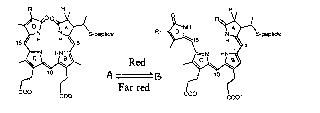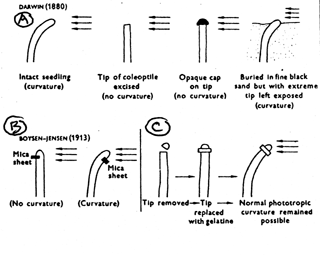From Bio 275, February 11, 1999
Once you have looked at a question, you may access a brief outline of the answer by selecting the highlighted area in the question and tapping Enter.
To return to the questions, simply select the highlighted option below each answer.
Instructions: Please read the questions carefully and try to organize your answer before you start to write. Please try to be concise and limit your remarks to the question asked. Indicate with an X which questions are omitted. Check to be sure you have all 5 pages.
42 points (14 points each)
Each of these answers is restricted to about 1/2 page.
Answer 3 of the following 4 questions (1-4):
 2. Explain
what is going on in the reaction shown on the left and the significance
of these changes.
2. Explain
what is going on in the reaction shown on the left and the significance
of these changes.
(Click on the image to the left to enlarge it;
use the Back button on your browser to return to this page.)
3. Using specific examples, discuss
the idea that a given hormone may exert very different effects
(possibly through different modes of action) in different tissues,
even within the same plant.
4. Explain what an action spectrum is and how it can be used to determine the identity of a photoreceptor.
32 points (8 points each)
Briefly, explain what 4 of the following (5-9) are.
Each of these answers is restricted to 3 lines.
6. 2,4,5-T
7. Cryptochrome
8. Growth
9. Fusiccocin
24 points (8 points each)
Briefly, explain the functions of any 3 of the following (10-13). Be careful not to explain what they are unless that is part of their function.
Each of these answers is restricted to 3 lines.
10. R/FR ratio
12. Cytokinin
13. Coleoptile
February 11, 1999
 1. Explain the significance
of each group (A, B & C) of experiments diagrammed on the left.
1. Explain the significance
of each group (A, B & C) of experiments diagrammed on the left.
(Click on the image to the left to enlarge it; use the Back button
on your browser to return to this page.)
A) These experiments show that light is perceived in the tip
of the coleoptile. With additional data, the Darwins also concluded
that the tip caused the lower part to grow and that the binding
was due to unequal growth.
B) These experiments show that the growth-promoting influence
from the tip travels down the dark side of the coleoptile, not
the side toward the unilateral light. The mica sheet, which is
impermeable, blocks the movement of the growth-promoting influence down from the
tip.
C) This experiment shows that the growth-promoting influence from the tip is able
to cross a nonliving barrier (the gelatin wedge).
A similar set of answers emphasizing the role of auxin instead of a growth-promoting is possible
and acceptable.
 2. Explain what is going
on in the reaction shown on the left and the significance of these
changes.
2. Explain what is going
on in the reaction shown on the left and the significance of these
changes.
(Click on the image to the left to enlarge it; use the Back button
on your browser to return to this page.)
This reaction shows the chromophore of phytochrome undergoing
conformational changes as it changes from Pr (A) to Pfr (B) and
back. This conformational change in the chromophore also changes
the conformation of the proteins in phytochrome and effects their
activity. The Pfr(B) is the active form, and this exerts various
effects. This pigment also senses he presence or absence of light
and the R/FR ratio, thereby playing an important role in coordinating
plant development with the environment.
3. Using specific examples, discuss the idea that a given hormone may exert very different effects (possibly through different modes of action) in different tissues, even within the same plant.
Different tissues are programmed to respond to hormones in different ways. To some extent, this may be due to different receptors in different tissues or it may be that the same receptor does different things in different tissues. A specific hormone, e.g., cytokinin may exert quite different effects, e.g., changes in gene expression or membrane permeability. Another kind of example is provided by auxin's effects on cell wall softening, i.e., auxin softens the cell wall in coleoptiles but it prevents cell wall softening in the abscission zone of leaves, seemingly opposite effects from the same hormone.
4. Explain what an action spectrum is and how it can be used to determine the identity of a photoreceptor.
An action spectrum is a graph of the effectiveness (action) of different wavelengths of light (given in equal doses) on a light-affected process vs. wavelength. The action spectrum can be compared to absorption spectra for various pigments to determine which pigment mediates the process affected by light. Usually, the action spectrum will resemble the absorption spectrum of the photoceptor involved.
5. Polar transport is directional transport of auxin which occurs outside of the xylem and phloem, is driven by ATP (i.e., is active)and is faster(10x) than diffusion.
6. 2,4,5-T is a synthetic auxin which is used as a herbicide.
7. Cryptochrome is a blue light-absorbing photoreceptor which is a protein associated with riboflavin.
8. Growth is an irreversible increase in size or volume.
9. Fusicoccin is a fungal toxin which may stimulate H+ ion pumping causing cell wall softening and cell growth.
10. The R/FR ratio provides an index of shading by other plants. This allows plants to perceive the shade provided by other plants and stimulates stem growth to enable the plant to find more light.
11. Second messengers are interacellular messengers that amplify hormonal and light signals. These secondary messengers bind to effector proteins and initiate a further response.
12. Cytokinins inhibit senescence, stimulate cell division, promote bud initiation, draw nutrients, alter membrane permeability and antagonize ABA.
13. Coleoptiles are cylindrical sheaths which cover and protect the young leaves of grass seedlings.